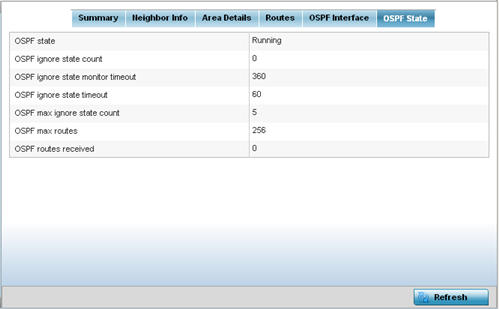AP OSPF State
An OSPF enabled access point sends hello packets to discover neighbors and elect a designated router for dynamic links. The hello packet includes link state data maintained on each access point and periodically updated on each OSPF member. The access point tracks link state information to help assess the health of each OSPF dynamic route.
To view OSPF state statistics:
- Select the Statistics menu from the Web UI.
- Expand the System node from the navigation pane (on the left-hand side of the screen). The System node expands to display the RF Domains created within the managed network.
- Expand an RF Domain node, select a controller or service platform, and select one of its connected access points. The access point's statistics menu displays in the right-hand side of the screen, with the Health tab selected by default.
- Expand the OSPF menu.
- Select the OSPF State tab.The screen is displayed
 The OSPF Statetab describes the following:
The OSPF Statetab describes the following:OSPF state Displays the OSPF link state amongst neighbors within the OSPF topology. Link state information is maintained in a LSDB (link-state database) which is a tree image of the entire network topology. Identical copies of the LSDB are periodically updated through flooding on all OSPF supported nodes. Flooding is the part of the OSPF protocol that distributes and synchronizes the link-state database between OSPF routers.
OSPF ignore state count Lists the number of times state requests have been ignored between the access point and its peers within this OSPF supported broadcast domain.
OSPF ignore state monitor timeout Displays the timeout that, when exceeded, prohibits an access point from detecting changes to the OSPF link state.
OSPF max ignore state count Displays whether an OSPF state timeout is being ignored and not utilized in the transmission of state update requests amongst neighbors within the OSPF topology.
OSPF max routes States the maximum number of routes negotiated amongst neighbors within the OSPF topology.
OSPF routes received Lists the routes received and negotiated amongst neighbors within the OSPF topology.
- Select Refresh to update the statistics counters to their latest values.



